Last year marked 20 years since the deadliest accident in the history of Italian aviation. In October 2001, the Linate Airport disaster saw more than 100 people lose their lives due to a ground collision at Milan's most centrally-located commercial airport. The tragedy involved a Scandinavian Airlines McDonnell Douglas MD-87 and a private Cessna Citation CJ2.
The aircraft involved
Let's start by establishing the nature of the two aircraft that were involved in the Linate Airport disaster. One was a Scandinavian Airlines McDonnell Douglas MD-87 registered as SE-DMA. Bearing the name Lage Viking, ATDB.aero shows that it spent its entire career at SAS, having joined the joint Danish, Swedish, and Norwegian flag carrier in September 1991.
The date of the accident was October 8th, 2001. On this day, SE-DMA was set to operate a direct flight from Milan Linate (LIN) to Copenhagen Airport, Kastrup (CPH) in Denmark. This service bore the number SK686, and it had 104 passengers and six crew onboard.
Also set to depart Milan Linate that morning was a Cessna Citation 525A CJ2 business jet. Bound for Paris Le Bourget Airport (LBG), there were just four people onboard: two pilots and two passengers. It was registered in Germany as D-IEVX, and operated by Air Evex.
Stay informed: Sign up for our daily and weekly aviation news digests.
Foggy conditions
On the morning of October 8th, 2001, foggy conditions prevailed at Milan Linate Airport. Such weather can reduce visibility to minimal levels, potentially causing severe operational disruption at airports. There is a very real danger to it, as misunderstandings can be fatal in low visibility. Indeed, fog was a contributing factor in 1977's Tenerife Airport disaster.
In terms of the Linate Airport disaster, fog on the Monday morning in question limited visibility to less than 200 meters. However, The Guardian quotes Vincenzo Fusco, the airport's director, stating that conditions were still suitable for flying. Fusco explained that "there was fog at the time, but conditions were absolutely compatible with flight operations."
Incorrect taxi procedures
When the Cessna Citation was ready to depart, it received instructions on how to taxi to the southern end of runway 36R, ready for its departure. Starting its journey from the northwest of the airfield, it was advised to use taxiway R5. This would take it around the northern end of runway 36R, and onto the airport's northern apron and the main taxiway.
However, lost in the fog, the Cessna's pilots instead traveled southeast on taxiways R6 and S4. This route took it across runway 36R at around the location where taxiway R2 joins the landing strip from the east. The lack of a ground radar system at the airport, which would have alerted controllers to the Cessna's diversion, meant that this went unnoticed.
A deadly collision
Meanwhile, SE-DMA, the Copenhagen-bound SAS MD-87, had taxied almost directly south from Linate's main apron, to the southern end of runway 36R. With Denmark being situated north of Italy, this would give the rear-engined twinjet a direct route out of Milan, without needing to turn around, as would have been the case had it departed southwards.
At 08:09, air traffic control advised flight SK686's pilots that they were clear to take-off. Interestingly, this instruction came from a different controller to the one who informed the Cessna Citation of its authorized taxi route to the southern end of runway 36R.
Less than a minute after this clearance, the departing MD-87 collided with the Cessna as it crossed the runway. Accelerating at around 150 knots (280 km/h), the stricken airliner did briefly get airborne, despite losing its right engine. It reached a height of 40 feet (12 meters) before crashing back down to earth, with its pilots now attempting to stop the jet.
However, their efforts were in vain, with the damaged twinjet colliding with a baggage hangar at the end of the runway at 136 knots (252 km/h). The Guardian notes that the disaster could have been even more catastrophic, had the building not been there. This is because the impact prevented the MD-87 from careering onto a busy adjacent road.
Tragedy in Milan
The shocking death toll was record-breaking for both SAS and the country of Italy as a whole. All 110 occupants of the MD-87 died due to the impact with the baggage hangar, in what was SAS's first fatal accident since the crash of flight 933 near Los Angeles in January 1969. It remains the worst involving SAS as well as its most recent fatal crash.
Additionally, all four occupants of the Cessna Citation perished in the disaster. The initial impact killed one of the four, with the other three sadly losing their lives in the resulting fire.
Additionally, the fire that broke out in the baggage hangar killed four people on the ground, as well as injuring another four. This brought the total death toll for the tragedy to 118 people on the two aircraft and in the hangar, making it Italy's worst aviation accident.
Impact and legacy
Investigators noted that the accident's primary cause was the Cessna's incorrect taxi route. However, they also highlighted airport management shortcomings. These included the lack of a ground radar system that could have prevented the crash. As such, four members of the airport's management and air traffic control received jail sentences in April 2004.
Memorial services took place in Denmark, Italy, Sweden, and Norway in the days that followed. EuroNews notes that 20th-anniversary memorials also occurred last year, in the form of a minute's silence across all Italian airports. In terms of physical memorials, a nearby forest contains a sculpture and 118 beech trees dedicated to the victims.
Did you know about the Linate Airport disaster? What are your memories of the accident? Let us know your thoughts in the comments.






